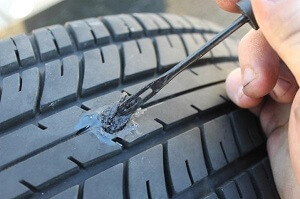How Much Does it Cost to Patch a Tire?
The punch-in-gut discovery of a slowly deflating tire while scrambling to important appointments is one of the worst feelings drivers have. When looking for solutions, most drivers dash directly toward the closest puncture repair shops rather than weighing expenditures first.
This article explores the real costs around patching tire punctures spanning national averages to cost-saving advice so pothole mishaps won’t also flatten savings.
How Much Does it Cost to Patch a Tire?
The cost of patching a singular tire puncture costs $15-$50 on average when you account for essential supplies, shop fees, and labor. The process means basically gluing protective rubber plugs into holes from nails or embedded debris. Straightforward repairs requiring 30 minutes generally hit the low end at around $20 assuming no sidewall involvement or additional wheel balancing is needed.
Larger punctures necessitating more adhesive patches plus mounting/dismounting mean costs of $40 or more. Always ask if fees include rotations ensuring dependability rather than just plug insertion alone, which temporarily solves immediate deflation without examining overall tire integrity.
SuperMoney states that the cost of patching a tire is usually about $17-$35, depending on factors such as the depth of the puncture, whether it affects the sidewall, and the use of a tire plug or a tire patch with tire sealant. If done at a repair shop, the cost is around $35, including the patch and labor.
According to a towing company in Texas, a simple repair costs somewhere between $15 and $30, involving the use of plugs to fill the leaks.
24/7 Car Unlocking has an article explaining that the average cost of changing a flat tire in Houston is $95-$120, depending on the service provider.
Kelley Blue Book features an average cost for tire repair of $54 to $64.
Of course, regional variances apply with small rural garages lagging metropolitan establishments substantially. But location pricing generally runs within:
- Small Town Tire Patch Cost Range – $15 to $35
- Major City Range – $25 to $50
- National Chain Range – $40 to $100
When possible, request total quote ranges accounting for worst-case scenarios beforehand.
Factors Affecting Tire Patch Pricing
Unlike replacing entire rubber sets, patching remains among the most affordable mechanical services given speed and supply simplicity. However key factors influencing pricing still include:
- Tire Size – Patch plugs and tools for large truck tires exceed passenger car needs, hence heavier repair bills
- Patch Extent – One stabilized hole is worth $20 while 6 errant nails reported at once increase the effort required and prices along with it
- Wheel Size – Low profile performance tires prove trickier balancing off rims adding costs over the basic 15” steel wheel variety
- Shop Payment Structures – Some garages levy both service minimums and supplies fees further elevating costs for even minor fixes
Of course with perpetually deflating mobility at stake as the alternative, drivers have little leverage when debating charges. So ask about potential price ranges beforehand establishing expectations and identifications around honest value calculations.
You might also like our articles on the cost of tires, run-flat tires, or donut tires.
Additional Charges to Consider
While preventing full tire blowouts and shredded sidewalls means patches rank among the industry’s most economical fixes, there are some services that add expenses:
- Mounting/Balancing – Rotation off rims for patch access and reseating means rebalancing prices for around $20 per tire
- Valve Stems – Rubber sealing valve cores degrade over years occasionally requiring a $10 replacement during patching driveway drop-offs
- Taxes – Most municipalities have sales tax on rendered services with tires representing reusable assets qualifying for added percentage recapture
- Disposal Fees – Scrap rubber and lifelong patch materials require regulated handling and processing fees avoiding illegal dumping amounting to a couple of dollars
While essential for ongoing mobility, aligning expectations on inevitable expenses allows drivers to better understand patching costs as unavoidable maintenance rather than perceived price gouging.
Evaluating Tire Damage – Repair vs. Replace Decisions
 The repairability of tires depends largely on damage size and positioning. Here are the usual possibilities:
The repairability of tires depends largely on damage size and positioning. Here are the usual possibilities:
- Punctures/Cuts Less Than 1⁄4 Inch – Generally patchable unless exceeding two per tire or occurring past tire threads nearer sidewalls.
- Larger Punctures – Holes over 1⁄4 inch in diameter often require full replacements to safely contain air pressure for responsive braking/handling.
- Sidewall Bulges and Exposed Belt – Indicate weakened structural integrity necessitating new tires. Age degradation also risks blowouts despite intact treads.
When most damage seems patchable, technicians carefully examine full interior tire walls searching for additional weakening before greenlighting fixes. Better safe than sorry is still the mindset protecting passengers while on the road.
How to Prevent Costly Tire Damage
Consistency is essential in monitoring tire health and preventing irreparable damage through:
- Monthly Inspections – Look for protruding objects like nails, curb scuffs, and abnormal tread wear.
- Proper Inflation – Underinflation causes dangerous overheating degradation and uneven wearing while overinflation reduces gripping traction.
- Rotation Adherence – Front and rear tires suffer different strains (traction versus braking) so regular crossover extensions use cases more evenly distributing wear.
Final Words
When vehicles rely on four fragile rubber contact patches while going through debris fields daily, occasional punctures seem inevitable much like brake pad erosion and wiper insertions. Thankfully, at approximately $30 per hole, patches represent the most cost-effective insurance protecting far more expensive tire assets and safety, unlike other automotive fixes.
Going to the repair shop informed on realistic plug pricing allows you to embrace puncture repair costs as routine ownership expenses rather than reactive budget-breaking blows.


Leave a Reply
Want to join the discussion?Feel free to contribute!